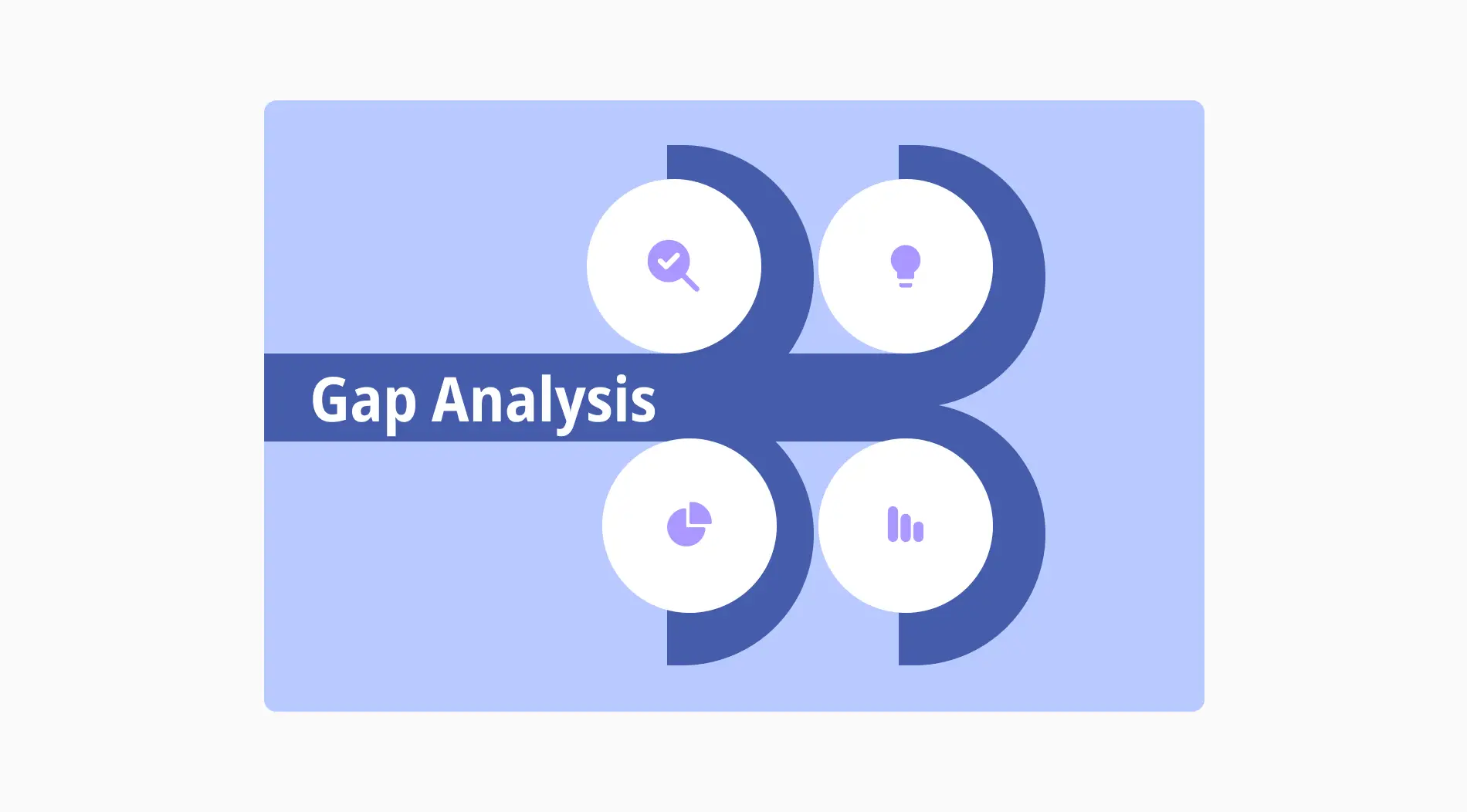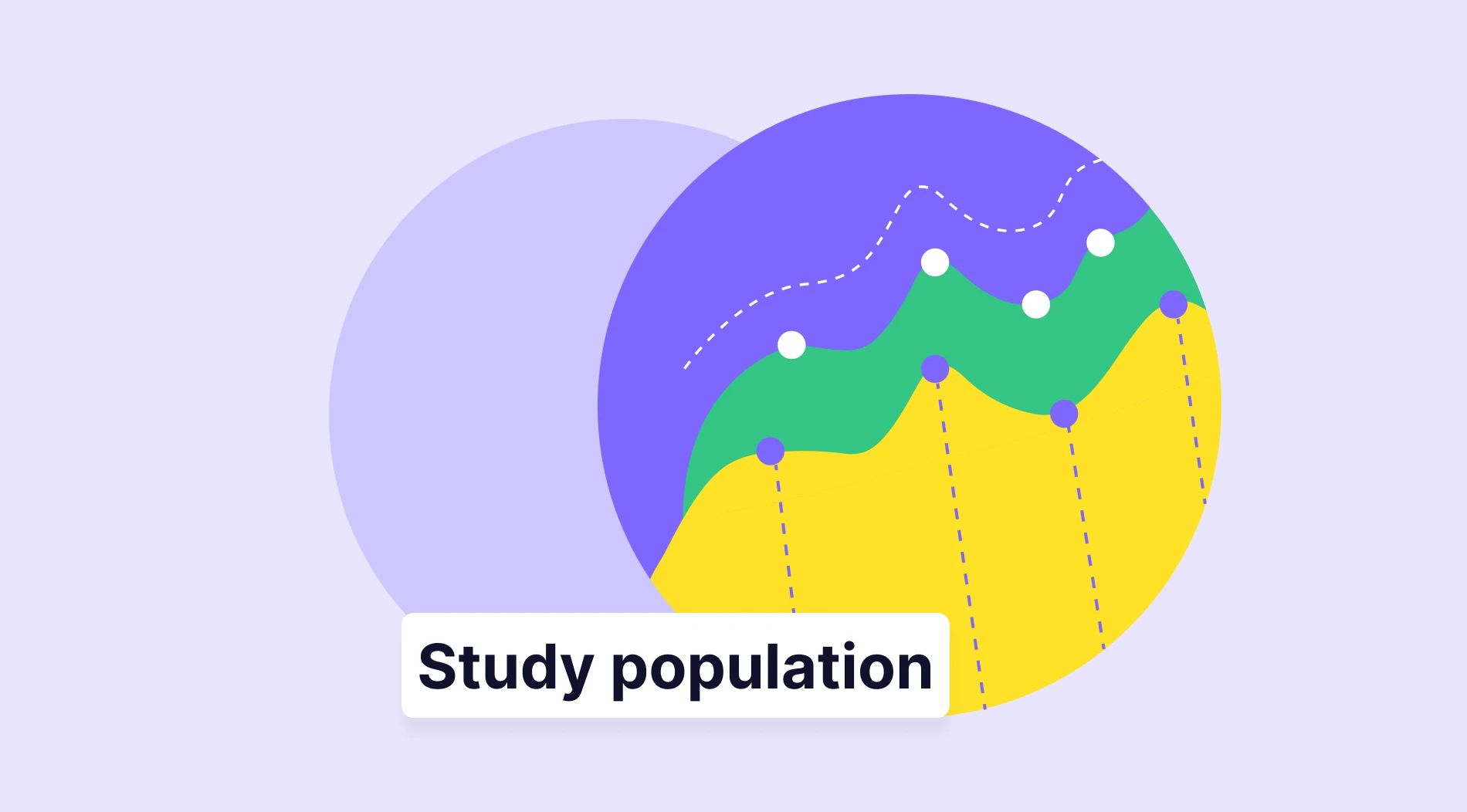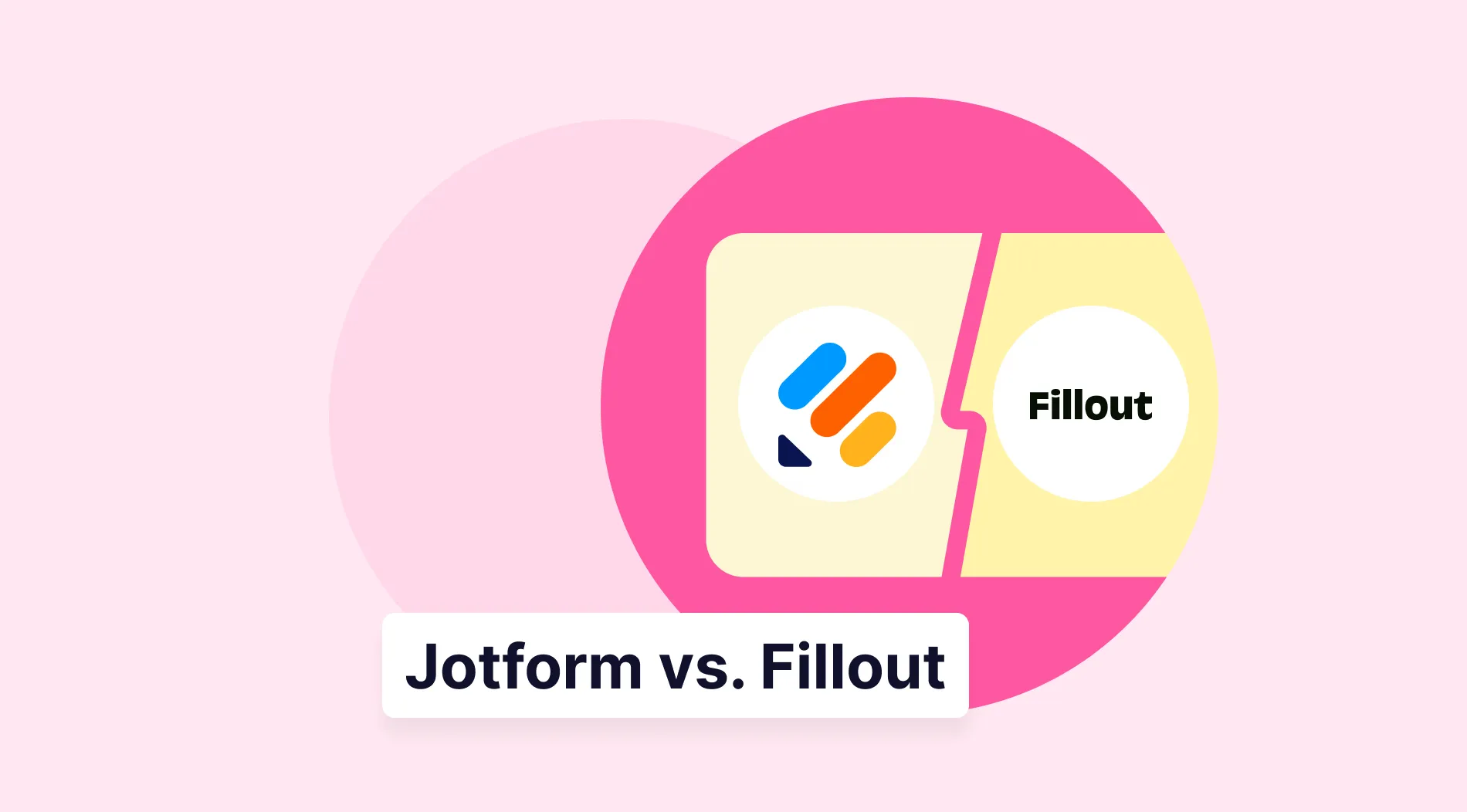Today’s business world requires you to stay competitive. For this, you need continuous improvement and strategic planning. There are a lot of analyses to help your company identify gaps between its current performance and desired goals. If you can understand these gaps, your company can develop actionable plans to enhance efficiency, productivity, and profits.
In this article, we will cover one of these analyses, the Gap analysis. We will explore all its aspects, its different types, and the steps to take to conduct one. Additionally, we’ll look at the tools used in Gap analysis, their suitable contexts, and why they should be used. Finally, we’ll answer some of the most frequently asked questions about the subject.
What is a Gap analysis?
Gap analysis is a method used to compare actual performance with potential or desired performance.
It identifies the differences between current capabilities and future requirements. The Gap analysis helps your organization understand where it is, where it wants to be, and how you can bridge this gap. In this analysis, you need to identify specific areas needing improvement and create targeted strategies.
Your company can use Gap analysis to assess its current performance against industry standards or benchmarks. This process involves collecting data on current operations, identifying desired outcomes, and analyzing the gaps between them. The results of the Gap analysis will provide insights into areas that require your attention and resources. These insights will help you stay ahead of your competitors.
Types of Gap Analysis
Now that we are familiar with the concept of the “Gap Analysis”, let’s look at different types of the Gap Analysis. You can use these variants in your business to address different aspects of your organization/company. Here are some of the Gap analysis types:
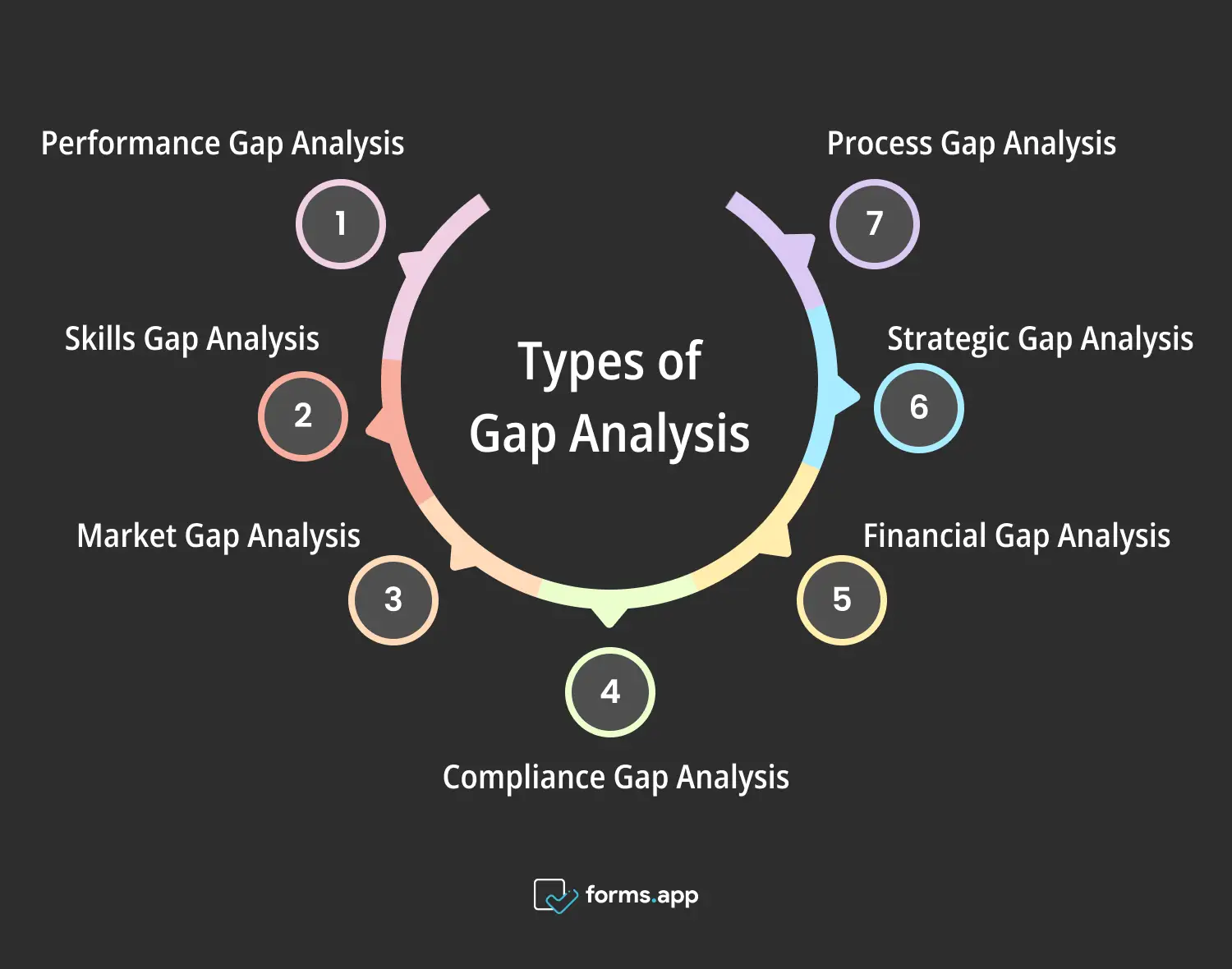
Gap Analysis types
1- Performance Gap Analysis
Performance Gap Analysis focuses on identifying differences between actual performance and desired performance levels. This type of analysis examines key performance indicators (KPIs) to determine areas where your company is falling short. When you understand these gaps, you can implement corrective actions to improve efficiency, productivity, and overall performance.
Performance Gap analysis is essential for setting realistic targets, measuring progress, and ensuring that you meet your strategic goals. It will provide you with a clear picture of your current performance levels and highlight areas for improvement.
2- Skills Gap Analysis
Skills Gap Analysis identifies the difference between the skills your employees have and the skills required to meet your organizational goals. This analysis will help you understand the training and development needs of your workforce. When you conduct a Skills Gap Analysis, your company can create targeted training programs accordingly.
This will help you enhance employee capabilities and align them with your business objectives. This process also ensures that your employees have the necessary skills to perform their roles effectively, adapt to new technologies, and contribute to your organizational success.
3- Market Gap Analysis
Market Gap Analysis refers to identifying gaps in the market that your company can exploit. This type of Gap analysis focuses on understanding the customer needs, emerging trends, and competitive dynamics in your industry. If you can understand these gaps, you can develop new products or services, enter new markets, and create an advantage.
Market Gap Analysis also helps your organization stay ahead of your competitors, meet customer demands, and drive innovation. It will provide valuable insights into market opportunities and help in strategic decision-making.
4- Compliance Gap Analysis
Compliance gap analysis evaluates your organization’s adherence to regulatory requirements, industry standards, or internal policies. This analysis involves documentation and practices to identify your company’s deviation from compliance standards. Identifying compliance gaps helps your organization mitigate risks, avoid legal penalties, and maintain trust with your customers.
By addressing these gaps, your business can ensure that it meets all necessary regulations and standards. When you conduct this analysis and remain compliant with the regulations, you will protect your brand reputation. You will also be able to reduce the risk of non-compliance issues.
5- Financial Gap Analysis
Financial Gap analysis is also known as the profit gap analysis. It compares your organization’s current financial performance against desired or projected targets. It involves evaluating your revenue, expenses, and profits to identify areas for improvement. When you understand these gaps, your company can develop strategies to improve its financial health, such as cost-cutting measures.
This analysis is crucial for maintaining your financial stability. It will allow you to optimize resource allocation and achieve long-term financial goals. You can also try strategies such as revenue diversification or specific investment planning with this analysis.
6- Strategic Gap Analysis
Strategic Gap Analysis examines the differences between your company’s current performance and its strategic goals. This review includes various aspects such as sales, productivity, and efficiency compared to the benchmarks. Your company can evaluate its market share against competitors to identify strategic gaps.
By understanding these gaps, you can develop targeted strategies to achieve your long-term objectives, such as entering new markets. You can enhance your product offerings and optimize your processes. Strategic gap analysis helps your company stay aligned with your vision and mission. It ensures sustained growth and competitive advantage.
7- Process Gap Analysis
Process Gap Analysis evaluates the efficiency and effectiveness of organizational processes. It does so by comparing them against best practices or standards. This analysis will help you identify challenges, redundancies, and areas for improvement. For example, your company can analyze its supply chain or improve its project management.
If you understand and address these process gaps, your company can enhance productivity, reduce costs, and improve overall operational efficiency. It also ensures smoother and more effective workflows between your departments.
Gap Analysis steps
We have looked at different types and approaches to the gap analysis. You can implement the Gap analysis focusing on different aspects of your business. Now, let’s explore which steps to follow to successfully implement a gap analysis. Here are 6 steps for a proper gap analysis:
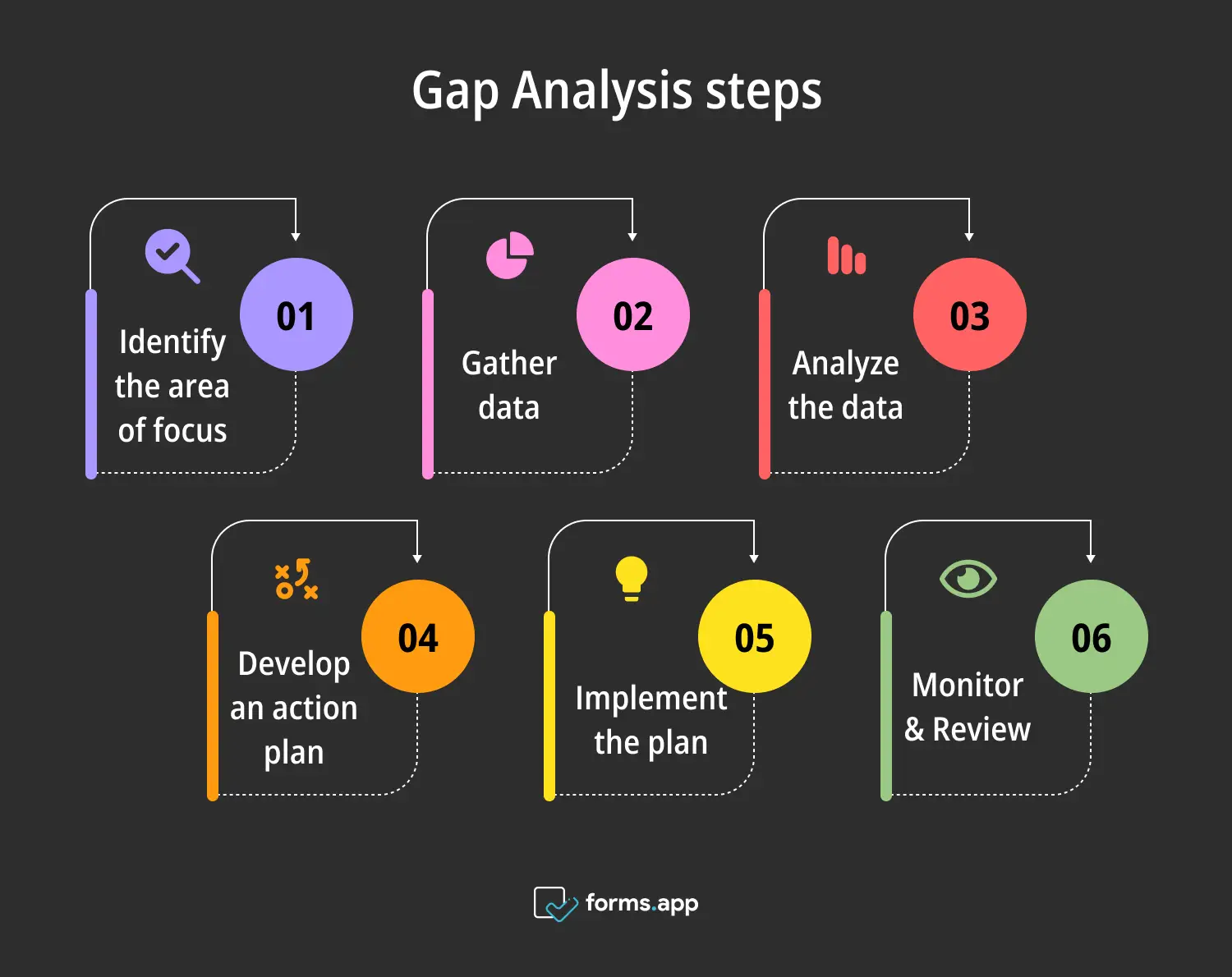
Steps for Gap Analysis
Step 1: Identify the area of focus
The first step in conducting a Gap Analysis is identifying the specific area or process needing improvement. This could be a business function, a department, or your entire company. Clearly define the scope of the analysis and ensure you focus on the process properly. Understand the current state of your company, set your objectives, and determine the desired outcomes.
Step 2: Gather data
Once you identify your area of focus, start gathering relevant data. Collect information on your company’s performance, human resources, and processes. You can obtain data through various methods, including surveys, interviews, observations, and performance reports. Accurate and comprehensive data is essential to identify gaps and understand root causes. This step provides you with a factual basis.
Step 3: Analyze the data
You must analyze the data collected to identify the gaps between your current performance and desired outcomes. Compare actual results with targets, benchmarks, and best practices. The analysis helps you understand the extent and nature of the gaps. You can also identify the potential barriers and challenges to be addressed. Analyze the data and prioritize areas requiring attention.
Step 4: Develop an action plan
After identifying the gaps, develop an action plan to address them. This involves setting specific, measurable, achievable, relevant, and time-bound (SMART) goals. Your action plan needs to outline the steps required to close the gaps. It also needs to assign responsibilities and allocate resources. Your action plan will include timelines and milestones to track your progress.
Step 5: Implement the plan
Once you have developed your action plan, you need to implement it. Execute the planned activities, monitor progress, and make the necessary adjustments. To effectively implement your plan, you need clear communication and stakeholder engagement. Regular progress reviews help you identify deviations and take the necessary corrective actions.
Step 6: Monitor & Review
Our final step involves monitoring and reviewing the outcomes. Track your progress against the action plan, measure the results, and evaluate the effectiveness of your actions. Continuous monitoring will ensure your company stays on track and achieves its strategic goals. This step will be dynamic and support your continuous improvement.
Tools for Gap analysis
We have seen the general steps to implement a Gap analysis successfully. However, you can also use different tools and models along the process. These strategic tools and models will help you analyze more quantitatively and analytically. Here are some of the Gap Analysis tools:
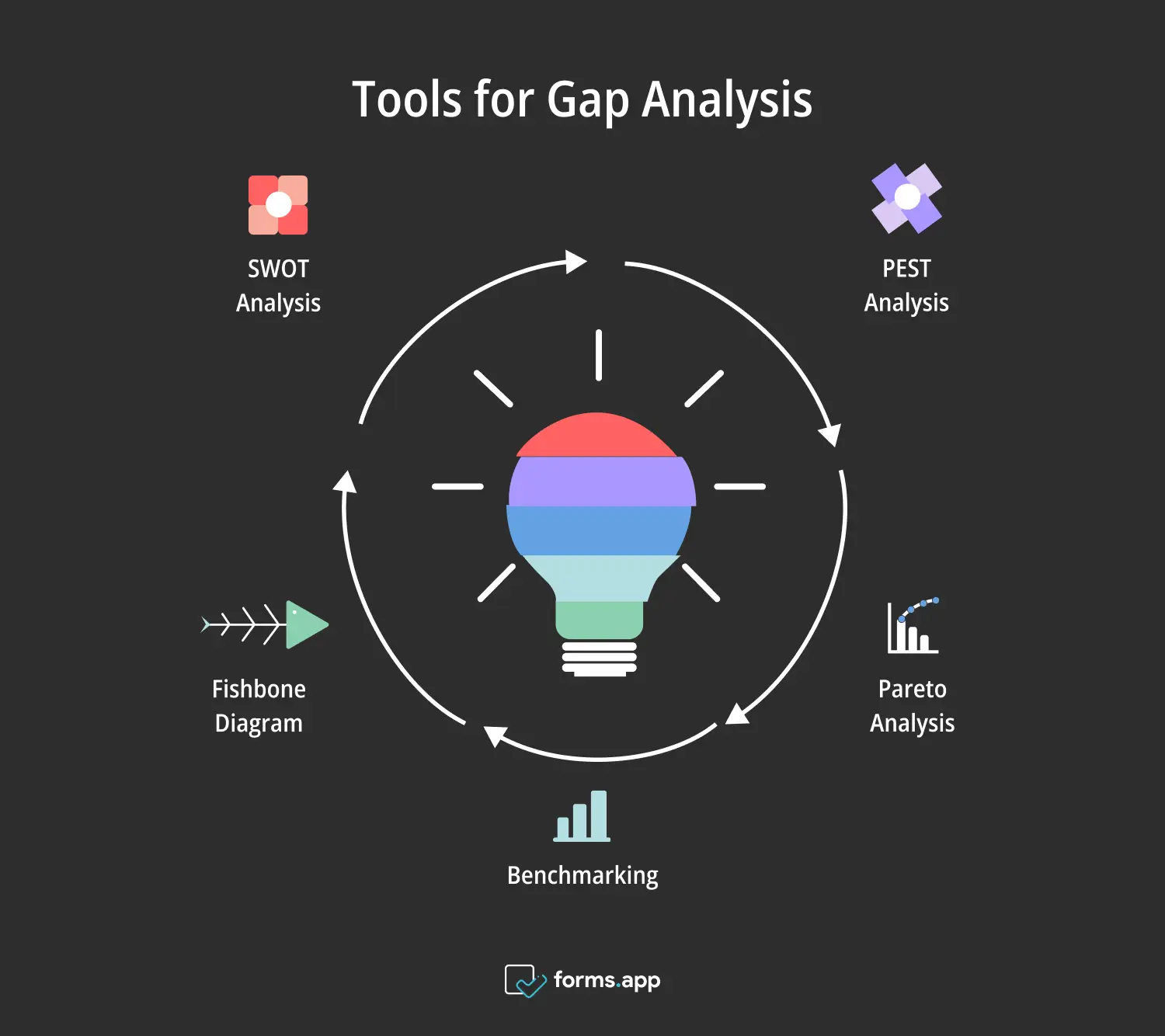
Gap Analysis tools
Tool 1: SWOT Analysis
SWOT Analysis is a strategic tool that examines your organization’s strengths, weaknesses, opportunities, and threats. By conducting a SWOT analysis, your business can comprehensively understand internal and external factors impacting performance. Strengths and weaknesses are internal factors, while opportunities and threats are external. This analysis helps identify gaps between current capabilities and market demands.
By leveraging strengths, mitigating weaknesses, and addressing threats, your company can develop strategies to bridge performance gaps. SWOT Analysis provides valuable insights for strategic planning, decision-making, and improving competitive advantage.
Tool 2: Fishbone Diagram
The Fishbone Diagram, also known as the Ishikawa or cause-and-effect diagram, helps identify the root causes of a problem. It visually maps out the various factors contributing to a specific issue, making it easier for you to identify areas for improvement. The diagram resembles a fishbone. You put the problem at the head and potential causes at the branches.
You can also use categories such as people, processes, materials, and equipment. You can systematically analyze these categories and find out issues leading to performance gaps. The Fishbone Diagram is a powerful tool that you can use during your Gap Analysis process. It will enable you to solve problems and develop targeted action plans.
3- Benchmarking
Benchmarking involves comparing your organization’s performance against industry standards or best practices. This process helps you identify performance gaps by highlighting differences between your company and top performers. Benchmarking can focus on various aspects, such as processes, products, services, or overall performance. You need to understand how leading companies achieve superior results.
You can adopt best practices to improve your performance. This tool provides a reference point for meeting your performance targets and developing strategies to close gaps. Benchmarking is essential for continuous improvement. It ensures that your company remains competitive and aligns with industry standards.
4- Pareto Analysis
Pareto Analysis is based on the Pareto Principle (also known as the 80/20 rule). It identifies the most significant factors contributing to a problem. It helps your company focus on the vital few causes that generate the most significant impact. You need to analyze the data and rank the issues based on their frequency or impact.
This approach enables your business to focus on your efforts and resources to address the most critical gaps. The Pareto charts are visual tools that help you illustrate the relative importance of different factors. Pareto Analysis is effective for identifying key areas needing improvement and achieving better outcomes.
Tool 5: PEST Analysis
The PEST analysis examines the external macro-environmental factors influencing your company’s performance. The acronym Trends for Political, Economic, Social and Technological Analysis. Evaluate the external factors so that your organization can identify potential gaps between its current operations and future requirements.
Political factors include regulations and policies, and economic factors cover market trends and economic conditions. Social factors encompass demographic changes and cultural trends. Technological factors involve advancements and innovations. PEST Analysis helps companies anticipate external changes. It also allows you to understand the implications and develop strategies to address gaps. This tool is very important for strategic planning and long-term sustainability.
Examples of Gap analysis
We have seen different tools that you can use during your Gap Analysis. Now, let’s look at examples of gap analysis. We’ll see scenarios from well-known companies and discover how they use the Gap Analysis to achieve positive results. These examples will help you better understand the Gap Analysis.
Example 1: Microsoft (Skill Gap Analysis)
Microsoft conducts a skill gap analysis to address the evolving demands of the technology industry. The analysis reveals a significant employee proficiency gap in cloud computing and AI technologies. Microsoft implemented extensive training programs and certifications in Azure and AI to bridge this gap.
This initiative enhances employee skills and aligns with Microsoft’s strategic focus on cloud services and AI innovation. By addressing the skill gaps, Microsoft can maintain its competitive edge and support its growth in emerging technology areas.
Example 2: Toyota (Process Gap Analysis)
Toyota is a renowned automotive company for its production efficiency. It uses the process gap analysis to optimize its manufacturing processes. The analysis identifies the bottlenecks in the supply chain and production line inefficiencies. Toyota implements the Toyota Production System (TPS) and focuses on lean manufacturing principles for continuous improvement.
This approach significantly reduces waste, improves production times, and enhances product quality. The process gap analysis was pivotal in maintaining Toyota’s reputation for high efficiency and reliability in automotive manufacturing.
Example 3: Coca-Cola (Market Gap Analysis)
Coca-Cola conducts a market gap analysis to explore opportunities in the health-conscious beverage market. The analysis identifies a growing customer demand for low-sugar and healthy drink options. In response, Coca-Cola introduces a range of new products, including Coca-Cola Zero Sugar and various flavored sparkling waters.
This strategic move allows Coca-Cola to capture a new customer segment and address changing consumer preferences. The market gap analysis is crucial in helping Coca-Cola diversify its product portfolio. It also helps the company stay relevant in a dynamic market environment.
When to use Gap Analysis
Now, let’s look at the suitable environments and contexts in which you can use the Gap Analysis. Understanding these contexts will allow you to adapt the Gap analysis to your business in a more effective manner:
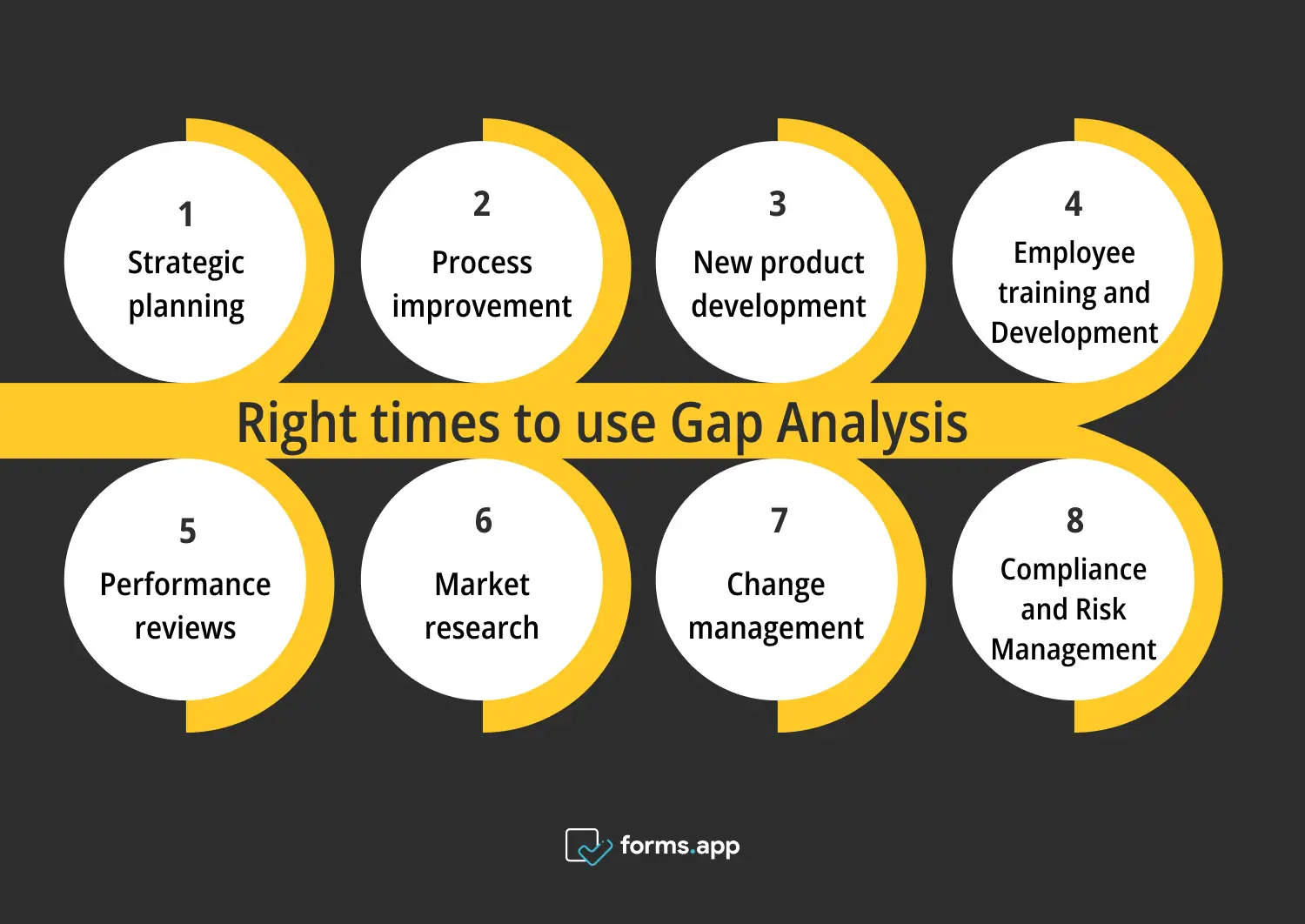
Correct times to use Gap Analaysis
1- Strategic planning
Use Gap Analysis during strategic planning to understand the difference between current performance and desired future outcomes. This method helps identify areas that need improvement and provides a clear roadmap for achieving organizational goals. By analyzing gaps, your business can set realistic and achievable targets. Gap Analysis in strategic management and planning is pretty useful.
2- Process improvement
Gap Analysis is essential for process improvement initiatives. It helps you identify inefficiencies and areas where processes deviate from best practices or desired performance levels. When you understand these gaps, your organization can develop targeted strategies to focus on operations, reduce waste, and enhance productivity. This analysis provides a structured approach to identifying the root causes of process issues.
3- New product development
Use Gap Analysis when developing new products or services. This analysis helps you identify gaps between current capabilities and the requirements for successful product development. It ensures that all necessary resources, skills, and processes are in place to meet market demands and customer expectations.
4- Employee training and Development
Gap Analysis is crucial for identifying your workforce's skill gaps and training needs. It helps your company understand the difference between the current skill levels of your employees and the skills required to achieve business objectives. When you conduct a Skills Gap Analysis, your company can create targeted training programs and enhance employee capabilities.
5- Performance reviews
During performance reviews, you can use Gap Analysis templates to assess your employees and company’s performance against predefined targets or industry benchmarks. This analysis identifies the performance gaps. It provides insights into areas that require improvement. When you understand these gaps, your company can create an action plan to enhance performance and set realistic goals.
6- Market research
Gap Analysis (marketing context) is valuable in market research to identify unmet customer needs, market opportunities, and competitive gaps. It helps your company understand the difference between current market offerings and customer expectations. Analyze these gaps so that your business can develop new products or services. Gap analysis in research is very effective.
7- Change management
Gap Analysis is essential for change management initiatives. It helps you understand the impact of changes and identify gaps that need to be addressed. This analysis enables you to plan and implement changes effectively. You can highlight the areas requiring additional resources, training, or process adjustments. If you address these gaps, your company can minimize disruptions and ensure a smooth transition.
8- Compliance and Risk Management
Use Gap Analysis for compliance and risk management. It helps your business identify gaps between current practices, regulatory requirements, or industry standards. You need to understand these gaps to develop strategies to mitigate risks. Ensure compliance and avoid legal or financial penalties.
Why to use Gap analysis
Gap Analysis is a very beneficial tool for your business to use. Here, let’s look at some reasons why you should use Gap Analysis in your company. Understanding these reasons will also help you see the advantages of this analysis:
👉Enhance strategic planning: Gap Analysis enhances strategic planning by clearly understanding the differences between current performance and desired outcomes. It helps organizations identify areas for improvement and develop actionable strategies to achieve their goals.
👉Drive continuous improvement: Gap Analysis supports continuous improvement by identifying areas that require attention. Regularly conducting this analysis helps organizations stay aligned with their strategic goals and adapt to changing market conditions.
👉Identify skill gaps: Gap Analysis helps identify skill gaps and development needs within the workforce. Organizations can create targeted training programs to enhance employee capabilities by understanding these gaps. This analysis supports employee growth and development, improving job satisfaction and productivity.
👉Improve market competitiveness: Gap Analysis provides valuable insights into market opportunities and competitive dynamics. Organizations can identify market gaps by developing new products or services, entering new markets, and creating a competitive advantage.
👉Support change management: Gap Analysis supports effective change management by identifying gaps that must be addressed during transitions. This analysis helps understand the impact of changes and develop strategies to minimize disruptions. This is one of the reasons for the importance of gap analysis.
👉Set realistic goals: Gap analysis helps set realistic and achievable business goals. By understanding the current state and identifying what needs to be done, organizations can develop actionable plans to reach their objectives.
👉Enhance problem-solving: Gap Analysis supports problem-solving by identifying the root causes of performance issues. This structured approach helps in developing targeted solutions to address specific problems.
👉Optimize resource allocation: Gap Analysis enhances organizational performance by clearly showing where improvements are needed. This analysis supports the prioritization of initiatives and resource allocation.
Frequently Asked Questions about the Gap Analysis
Last but not least, let’s find answers to some of the most frequently asked questions about the Gap Analysis. Understanding these questions and answers will help you better solve the problems and address the challenges in your business:
Gap Analysis is a method used to compare actual performance with desired performance. It identifies the differences between current capabilities and future requirements, helping organizations understand where they are, where they want to be, and how to bridge the gap. This analysis supports strategic planning and continuous improvement.
Gap analysis is important because it helps organizations identify areas for improvement and develop targeted strategies. By understanding gaps, companies can enhance efficiency, productivity, and competitiveness. This analysis supports informed decision-making, resource allocation, and strategic planning, driving business growth and success.
Gap Analysis is conducted by identifying the area of focus, gathering relevant data, analyzing the data to identify gaps, developing an action plan, implementing the plan, and monitoring progress. This process involves comparing current performance with the desired future state, understanding the gaps, and taking steps to close them.
Key points to take away
In conclusion, the Gap Analysis is a powerful tool for identifying gaps between your company’s performance and desired outcomes. It supports strategic planning, continuous improvement, and effective decision-making. By understanding gaps, your organization can develop targeted strategies, allocate resources effectively, and drive business growth.
This article explored the Gap Analysis, its types, steps, tools, and suitable environments. We have also seen real-life examples and the reasons for using the Gap Analysis. Finally, we answered some frequently asked questions about the subject. We encourage you to apply Gap Analysis in your company to achieve strategic goals and drive continuous improvement.
forms.app, your free form builder
- Unlimited views
- Unlimited questions
- Unlimited notifications
